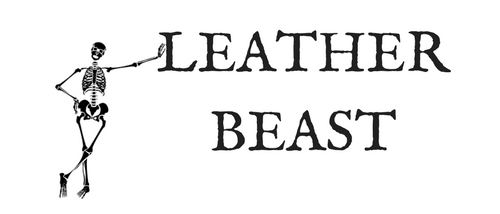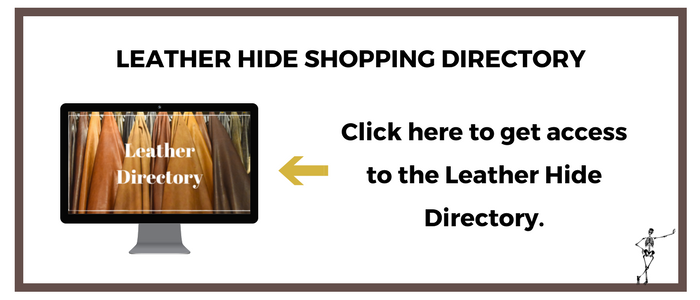Things to Know Before Buying Leather Hides
It can be overwhelming as a beginner leather worker when buying your first piece of leather for a number of reasons.
There are so many factors involved in shopping for leather like budget and general knowledge of the different types of leather that are available.
Not knowing the differences between the different types of leather can be a paralyzing thing when it comes to making a decision on a leather purchase.
I talked about leather grades, Chrome tanned vs. veg tanned and aniline and semi-aniline in great detail a few posts back on the blog. Check out those articles if you're not already familiar with some of the leather terminology, as this will help you greatly when purchasing leather.
To help you determine what to keep in mind when purchasing leather, I reached out to a few of my friends at my favorite leather hide suppliers and asked them all the same question...
What is the most important thing that a beginner leatherworker should keep in mind when purchasing leather?
Check out their responses in no specific order below.
1 | Rocky Mountain Leather Supply
Wow to pick one thing! When you first dive into leather craft choosing leather can be quite daunting. So many tanneries, types of leather, textures and thicknesses. It’s a lot to sample your way through! Take a deep breath and realize we all have a shelf of things we didn’t like, while expensive, the learning process has led us to find what we love! Its a learning curve, but hopefully we can help shorten it.
A nice thing to do is spend some time learning the difference between vegetable tanning and chrome tanning. These are the two most popular leather tannages. Each have different characteristics.
Veg Tan will traditionally be firmer than chrome tanned. These firmer leathers can be burnished more easily, they can take a crease well and can usually be molded. They are great for holsters, wallets, belts, shoe soles, tooling. While there are some softer forms of vegetable tanning that can be quite flexible, veg tan is traditionally more firm than chrome tanned leather, giving it its unique characteristics.
For chrome tanned leathers they are traditionally softer, this gives them some nice benefits of flexibility and usually brighter color options. But it being softer makes burnishing edges, creasing and molding more challenging. Chrome tanned leathers often use edge paint on the edges and a heated/heatable creaser. While there are some firmer forms of chrome tanned leathers, traditionally they are softer giving it its unique characteristics.
2 | Tandy Leather
Find a knowledgeable leather source like Tandy Leather and inform the associate of what type of project you plan to make so they may offer the best options for your project.
Ask lots of questions.
Mistakes happen, purchase more than you need in case you need to redo a particular part of the project. Find a leather that feels and looks good to you. You will have more pleasure with the production process when using a leather you are attracted to.
3 | Montana Leather Company
The most important thing to keep in mind as a beginning leatherworker is that you shouldn’t be afraid to ask questions.
There are so many different kinds of leather that shopping for the right piece can be overwhelming, and as a leather and craft supplier, we understand this.
We are here to help, so help us help you and ask questions!
4 | Leather Guy
There are probably a few things people should know when purchasing leather, I’ll try to keep it brief.
1-leather comes from actual animals, so how ever big the animal is, is how big the leather can be. For example, we get people asking for 12’ x 4’ sections of lamb…have you ever seen a 12’ long lamb?
2-dye lots change. Typically leather is dyed in about 2000 sq ft loads. Generally speaking that 2000 sq ft will match. But say you buy yellow today and in 6 months, they may not match.
3-animals are not square. While fabric is square, leather is odd shaped. There will be parts of the leather you may not be able to use like the edges.
4-ask questions of your leather supplier. We typically ask people what they want their finished product to look like so that we can suggest a leather. There are several different types of 3 oz leather, ie deerskin, upholstery grade, veg tanned but they all feel and work differently. So not only do you need to know the thickness you like, you really need to know the different types of leather too OR ask your leather supplier.
5 | Springfield Leather
I personally think the most important thing to keep in mind when buying leather is... Your going to have questions. Its that simple, make sure whoever you are buying leather from as a beginner is willing, and ABLE to answer your questions.
Sorry I don't have an answer that seems like a wow answer, but that is it, can they answer your questions.
There are many different facets to leather work, and no one knows everything but you really want someone who has a firm grasp of the facet you are interested in, or that they understand your need well enough to point you in the right direction.
As a beginner, the first question should be, "What kind of leather do I need to do ...... "
My biggest piece of advice when purchasing leather, is that you should know what you plan to make ahead of time before purchasing, as this plays a huge factor in what type of leather you should purchase.
You will then be able to determine the what weight of leather you should buy and what kind of cut or part of the animal is right for your project.
These are 2 very important things that you’ll want to think about based on what it is that you plan on making prior to making your leather purchase.
Comment below and let us know what the first thing is that YOU think about before purchasing your leather?




